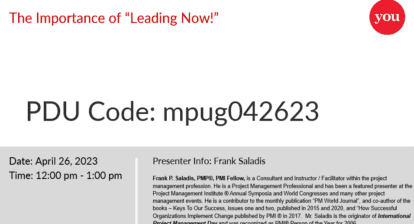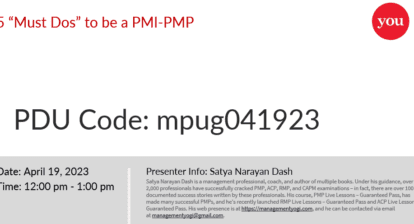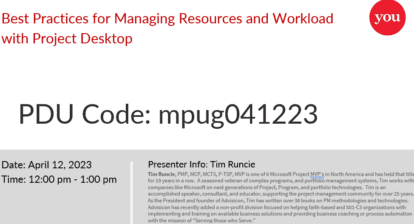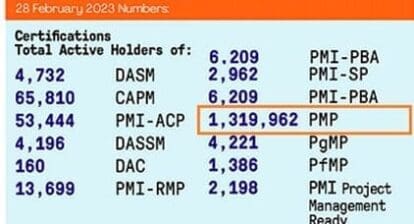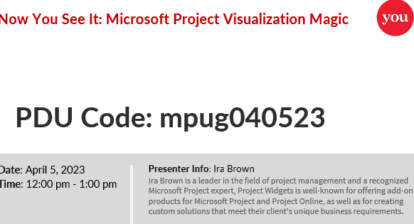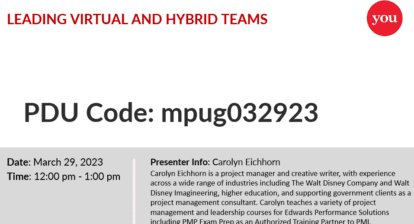
Would you hire an architect to build a new house if you hadn’t even seen photographs of some of his past designs? What about a plastic surgeon if you hadn’t seen proof of their past work?
Sure, the plastic surgery example is a bit tongue-in-cheek, but the underlying point is not. When people are looking to hire someone to perform a specific job, they don’t want to just hear a future employee say what they’ve done. Whether we’re talking an architect, a plastic surgeon, or yes, even a project manager, people hiring want to see evidence of past work in order to evaluate a potential candidate.
We know that seeing is believing and that a picture is worth a thousand words. Yes, there are a number of other clichés that drive this point home, but why do some professions rely so heavily on visual portfolios, while those of us who work in project management continue to stick to resumes alone? The next time you’re applying for your dream job in project management, perhaps a visual or two will set you apart from your competition.
In this article, we’ll explore some recommended best practices for building a visual project portfolio. Based on interactions with thousands of project managers, many of whom have moved from one PM role to another in the time that I’ve known them, I’ll give you my pointers for choosing the right projects, conveying your management skills visually, and maintaining confidentiality.
Selecting the Right Projects
The projects that you choose to display in your portfolio depend largely on the breadth and depth of your project management experience. If you have a long, storied career in project management, you’ll want to refrain from including too many projects. You want to make a good impression, but be selective. No hiring manager is going to look at more than a handful of examples anyway. If you’re relatively new to the world of project management, you’ll understandably have fewer projects from which to choose. Even if you have only ever managed one project in your life, you can create a few different views of that one project in your portfolio to draw people in. In general, a portfolio of three to five projects works well. Anything more than that, and you’ll overwhelm people. Anything less, and you’ll look like a one-hit-wonder.
When deciding what to include in your portfolio, you want to choose projects that show your experience across a wide array of assignments. If you’ve managed projects at several different companies or across different industries, diversity will come naturally. If you’ve worked in the same industry, or even at the same company for most of your career, don’t sell yourself short. You should still be able to select a diverse set of projects but may need to define “diverse” a little differently. Here are some guidelines:
Size:
Include a large and a small project. Size can be measured in terms of budget, in terms of duration, or in terms of the number people who were involved.
Methodology:
If you’ve managed the same type of project in different ways, show that you’re flexible. Agile and waterfall methodologies are two common methods in technology, for example. Many experienced PMs can switch back and forth.
Project vs. Portfolio:
Do you have experience managing an entire portfolio of multiple projects in addition to delivering individual projects? Show that you can manage at both a high and low level.
Special Skills:
Do you have special project management skills that you want to call out? Examples include managing international project teams, project rescue/turnarounds, and projects that involve multiple outside vendors. Each of these is a special skill that may be valuable to your next employer.
Building Your Portfolio
The goal of a visual project portfolio is to help prospective employers visualize how you have managed in the past. As a result, the pictorial quality of your portfolio is what will set you apart. You want to make sure that each project in your portfolio is depicted cleanly and succinctly. Include enough detail to help your prospective employer understand how you managed the project without creating information overload. Effective use of color, grouping/sorting, detail filtering, and annotations are all ways to tell your project story.
In addition to the visual, it’s good to include a few bullet points that your reader can use to compare different projects in your portfolio in an apples-to-apples way. This is where you’ll want to take a look at which dimensions you are using to illustrate yourself as a diverse project manager. For example, if your projects represent different durations or budgets, ensure that each one has a parallel bullet point that makes it easy to contrast.
Finally, you’ll want a few bullet points to summarize the nature of your project, what made it remarkable, and how it reflects your project management skills. It’s best to not copy and paste these details directly from your resume. New and unique information will be more engaging to your prospective employer. Don’t be afraid to air your dirty laundry here. Anyone hiring a PM knows that projects have their warts, and just because you were dealt an unlucky hand, doesn’t mean you shouldn’t be proud of the work you did to turn something around.
Mechanically, each project in your portfolio should represent a single page in a PowerPoint or PDF document. Roughly two-thirds of each page should be dedicated to the visual, with the rest being text.
Maintaining Confidentiality
When building a portfolio of your past projects, it’s important that you only share details that you are permitted to share. You don’t want your portfolio to get you into trouble with your current employer, nor do you want your prospective employer to get the impression that you cannot maintain confidentiality. We recommend using your resume as a guide for what should and should not be shared. If something is too sensitive to include in your resume or on your LinkedIn profile, it probably shouldn’t end up in your portfolio either.
When in doubt, you can always sanitize your project plan to ensure that important details don’t leak out. For example, instead of titling your project “Server Deployment for NSA”, shorten it to “Server Deployment.” You still get the point across without any loss of clarity.
Example Portfolio
Download an example portfolio consisting of a few made-up projects. These examples follow the best practices outlined above, and should give you some guidance for what might help you land your next project management job.
Related Content
Webinars (watch for free now!):
From Task Manager to People Manager – The Next Generation of Project Managers
Collaborative Project Management – Process & Power Skills
Articles:
Three Activities That Help Create an Authentic Workplace
Ten Project Management Truths
Communication: 5 Ways to Improve Your Project’s Lessons Learned

